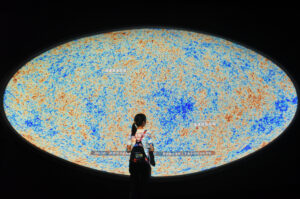by

There was a time before time when the universe was tiny, dense, and hot. In this world, time didn’t even exist. Space didn’t exist. That’s what current theories about the Big Bang posit, says Vijay Balasubramanian, the Cathy and Marc Lasry Professor of Physics. But what does this mean? What did the beginning of the universe look like? “I don’t know, maybe there was a timeless, spaceless soup,” Balasubramanian says. When we try to describe the beginning of everything, “our words fail us,” he says.
Yet, for thousands of years, humans have been trying to do just that. One attempt came 75 years ago from physicists George Gamow and Ralph Alpher. In a paper published on April 1, 1948, Alpher and Gamow imagined the universe starts in a hot, dense state that cools as it expands. After some time, they argued, there should have been a gas of neutrons, protons, electrons, and neutrinos reacting with each other and congealing into atomic nuclei as the universe aged and cooled. As the universe changed, so did the rates of decay and the ratios of protons to neutrons. Alpher and Gamow were able to mathematically calculate how this process might have occurred.
Now known as the alpha-beta-gamma theory, the paper predicted the surprisingly large fraction of helium and hydrogen in the universe. (By weight, hydrogen comprises 74% of nuclear matter, helium 24%, and heavier elements less than 1%.)
The findings of Gamow and Alpher hold up today, Balasubramanian says, part of an increasingly complex picture of matter, time and space. Penn Today spoke with Balasubramanian about the paper, the Big Bang, and the origin of the universe.
Read the full Q&A in Penn Today.
Balasubramanian is Cathy and Marc Lasry Professor in the Department of Physics and Astronomy in the Penn School of Arts and Sciences and a member of the Penn Bioengineering Graduate Group.
